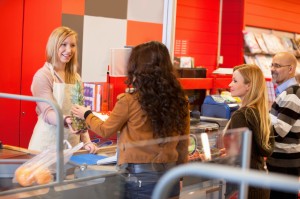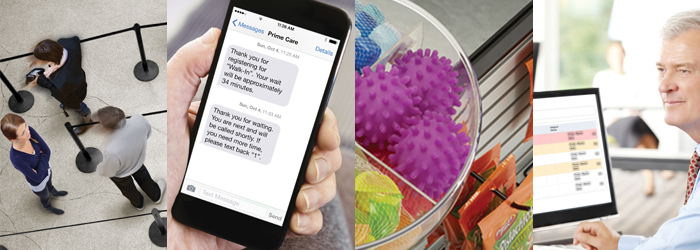A recent PricewaterhouseCoopers study on grocery stores – “Front of the Line: How Grocers Can Get Ahead for the Future” – suggests, along with personalizing marketing strategies, improving loyalty programs, and transforming technology, that retailers can enable change and improve what they offer customers by tailoring their brick-and-mortar stores to bring products closer to customers. This means locating stores closer in proximity to where your customers live and work, but also making stores easier to navigate for a “quick in-and-out.” One of the recommendations fitting within this idea is to facilitate a smooth checkout process. We have all experienced the grocery store checkout – sometimes it’s painless, sometimes it’s quite the opposite. Certain types of checkout options can hit a nerve with customers – congested stores and long checkout lines are top frustrations for shoppers, as PwC discovered – and this can impact customer loyalty. Here are some of our top tips to improve grocery store queuing to, in turn, create a smoother checkout process overall:
1. Consider a single-line queue

Flying in the face of traditional grocery store queuing and the commonly held belief that multiple lines are faster than a single line, there is something to be said for a single line queue that leads to multiple checkout stations. It is actually faster and fairer than multiple separate checkout lines for individual cashiers. Customers may have a hard time seeing the benefits if they’re standing in what looks like one long serpentine line, especially if they’re only going to the grocery store for a few items (in which case a separate “express” queue is still warranted). But, believe it or not, a single-line queue will improve service efficiency, shorten actual wait times, and lead to greater customer satisfaction. It’s just that initial hurdle that will take some convincing. Watch our video for a clever explanation: /en/resources-detail/make-it-a-single-line-queue.
2. Don’t neglect the self-checkout line
Because most self-checkout experiences are void of defined, easy-to-navigate queues, they lose out on the increased engagement and impulse sales inherent with traditional checkout lines. Here again, a well-defined, organized, single-line queue creates fairness, decreases customer frustration, and allows the introduction of in-line merchandising to the self-checkout process, engaging waiting customers, and boosting your bottom line through increased impulse sales.
3. Think with your “right” brain
The psychology of queuing – in other words, how people “feel” about their wait – is more important than the actual time spent waiting. This has been proven time and again and has resulted in a set of queuing tenets you should keep in mind. These include:
- Occupied time feels shorter than unoccupied time. Keep people distracted from focusing on the wait at hand by entertaining them, letting them shop in line, or allowing them to wander around (made possible with a virtual queuing system).
- Get them started. Let customers unload their cart before it’s their turn to checkout and they already feel better about the waiting experience because the transaction, to them, has already officially begun.
- Anxiety makes the wait seem longer. Once a wait lasts longer than three minutes, the perceived wait time multiplies with each passing minute. Diffuse anxiety with a single-line queue to eliminate the “Have I chosen the wrong line?” worry.
- Uncertain waits are longer than known, finite waits. Research has shown that people overestimate their wait times. With tools like real-time analytics you can inform customers about how long their wait really will be.
- Unexplained waits are longer than explained waits. Simple enough: If you’re making people wait, let them know why. They might not like waiting, but they’ll appreciate that you respect them enough to provide them with information. Some may not stick around, but many voluntarily will, and they’ll be less resentful in the long run.
- Unfair waits are longer than equitable waits. People want the wait to be fair. Customers consider never returning and shopping at another store because of poorly managed lines.
Grocery store shopping is part of our everyday lives, but fickle customers can just as easily go down the street to a competitor. The message to grocers is to take time to critically evaluate your queuing strategies. Even small improvements can go a long way toward improving customer satisfaction, impulse sales, and profitability.











